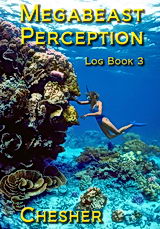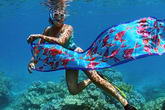Evolution of Domestic Cats and Whales
The domestic cat is the most successful of the entire cat family: in numbers, ease of life, and prospects of future survival. As a whole, man admires cats - I want to say instinctively - as a competent predator. Man admires cats so much he takes time to hunt and kill the larger ones to prove (I suppose) we are, indeed, king of the beasts.
So the great cats die and become few. But Felis domesticus (the greatest cat of all) is abundant and doing well. Why?
We feed it (when it wants to eat), cuddle it (when it wants petting), protect it and house it. We, mankind, have taken pussy cats all over the planet with us. Why?
Because we like cats (and they tolerate us.) Why?
Because we have selected cats for thousands of cat generations. Selected those we `liked' and killed the others. Our selection process enhanced the natural inclinations and abilities of the domestic cat.
Once upon a time there must have been a species of cat, ancestral to the modern domestic cat, that 'decided' to befriend man. The cat decided, not man. Other cats would not be domesticated but somewhere, a long time ago, there was a kind of cat which got along with man. Following camps, killing rats and rodents, making itself useful. The cat behaved well in man's sight, so man did not kill it, instead he began to protect and breed and keep this kind of cat.And only this kind. It was the cat's behavior which resulted in its being selected by man.
Once man started breeding cats, he selected those he liked without conscious thought. Nasty cats and ugly cats were killed and probably eaten. As a result, domestic cats evolved into something which was:
1) Interested in living with man, "innately" tied to man.
2) Innately liked by man.
The average human finds kittens irresistible. It is not a learned feeling, children adore kittens on first sight. It is an instinctive feeling, carried in our own genetic code. Because we bred them to fit our natural predisposition. They are ideal pets for many people because we designed them that way.
Now consider Homo sapiens. Four to five million years ago,
man was an omnivorous, hunting beast with a brain of about 530 ml capacity (about half a
pound). He was a well adapted, powerful creature with, no doubt, an elaborate social code.
Today, we call this stage of our development the Australopithecus man.
Our brains enlarged over another million years, to about 750 to 1200 ml capacity, producing fossil records we call Pithecanthropus man.
About one half million
years ago modern man, Homo sapiens was running around
the planet with our 1130 to 1570-ml (three pound)
brains. (Paleoneurology and the Evolution of the Mind.
Sci. Amer. 2341:90-101.)
Farming
and technology are only about 10,000 years old. This
means we were anatomically here for some 490,000 years
before we got busy and started mankind.
During these millennia, stone age tools of ancestral hominids were more or less the same everywhere and showed little or no signs of development.
Social, behavioral conditions were also more or less the same in all hominid populations.
Something changed our behavior, segregated us, made us different.
Something or someone.
For 20 million years there have been, on this planet, brains larger and more complex than modern man's.
Whale brains.
Whales were swimming Earth's seas with neurological equipment weighing up to 20 pounds before Man was even a recognizable ape.
The ancestral cetacean was probably an insect eating carnivore (creodonta) some 125 million years ago; distant cousins of the ungulates (today's cows, camels and hippopotami). At least that's what blood albumen and anatomical studies indicate. Even modern whales have 4-chambered stomachs like ungulates and tiny hind legs which appear during embryology.
45 million years ago the giant, carnivorous, totally aquatic Archaeoceti appeared. There are 30 million year old fossil records of baleen whales.
Toothed whales, like the sperm whales and dolphins, appeared 27 million years ago.
Whales evolved their present brain size, according to Jerison (1973), 20 million years ago.
The huge neopallium which Romer (1970) says is the site of the highest mental properties in man - learning, initiative, foresight, judgement - was proportionally larger in whale brains 20 million years ago than in Man's brain now.
Whales have no problem keeping alive. They spend no time or thought on farming, making weapons, defending themselves, or on possessions, money, or work schedules. Some, like baleen whales, swim easily through giant masses of unresisting krill, eating by opening their mouths and sieving the food-laden sea through their specially designed teeth. They don't worry about much.
So what do they think about with those large brains? Non-physical things. Social things. Abstract things. Interrelationships between things. For millions of years before the birth of man they have had time to think of non-physical things. Subjects primates have only recently begun to consider.
We know a little about higher levels of consciousness, mental telepathy, psychokinesis, clairvoyance. What do creatures with 20 pound brains who have been thinking about social interactions for millions of years know of such things?
We know a little about natural forces, places of power, evolutionary pressures. What do creatures who have been watching and learning for 20 million years know of evolution and the forces of nature?
Between each whale and every other whale, there is an energy link. Perhaps this link is limited to the easily detected and well known sonic vibrations - whale voices - as they call each other through the endless caverns of the seas. We know they converse with one-another over distances of thousands of miles.
The energy links might be more than just the sounds themselves but even if they are not, Cetacean languages carry vast amounts of information. And every transmission is a party line any whale can listen to. The speaking/listening of such a language weaves Cetacean neural structures into a mind web that spans oceans.
The whale brains, the sounds, the information transmitted, the complete mind web created by the sending/receiving process is a permanent feature of Sea. One that evolves in complexity each year. One recorded in thousands - once millions of enormous brains.
Maybe this oceanic mind-web is, itself, a form of consciousness. Sea's most sophisticated level of awareness.
Perhaps, after 19.5 million years of creative thinking, the collective awareness of the whales unraveled some of the deeper mysteries of life.
Could the universal whale mind know about DNA? Is this possible? Or at least what DNA does? Human brains figured it out. How deep does awareness penetrate the fabric of life? Why, just asking the question gives the answer. Awareness is a characteristic of all life. It penetrates - it emanates from - all levels of being, starting with DNA. Or perhaps before DNA?
What if this ancient whale mind, Sea's greatest and most complex mental web, decided it wanted or needed to do something besides just being there.
We bred cats for our pleasure. Perhaps whales, through some mechanism yet unknown to us, with their huge brains and vast experience, somehow altered conditions just enough, in just the right way, to create us for their pleasure or their needs.
I stop and look at what I have written and suddenly am back aboard the Moira.




